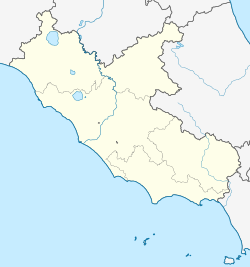
Back فروزينوني Arabic Frosinone AST فروزینونه AZB Frosinone BCL Фразінонэ Byelorussian Фразынонэ BE-X-OLD Фрозиноне Bulgarian Frosinone Breton Frosinone Catalan Фрозиноне CE
Frosinone | |
|---|---|
| Città di Frosinone | |
 Panorama of Frosinone | |
| Coordinates: 41°38′N 13°21′E / 41.633°N 13.350°E | |
| Country | Italy |
| Region | Lazio |
| Province | Frosinone (FR) |
| Frazioni | Capo Barile Nicolia, Colle Cannuccio, Colle Cottorino, Colle Martuccio, Fontana Grande, Frosinone Stazione, La Cervona, La Pescara, Le Pignatelle, Le Rase, Madonna della Neve, Maniano, Pratillo, San Liberatore, Selva dei Muli, Valle Contessa, Vetiche I, Vetiche II |
| Government | |
| • Mayor | Riccardo Mastrangeli (FI) |
| Area | |
• Total | 47 km2 (18 sq mi) |
| Elevation | 291 m (955 ft) |
| Population (31 August 2021)[2] | |
• Total | 44,087 |
| • Density | 940/km2 (2,400/sq mi) |
| Demonym | Frusinate(i) |
| Time zone | UTC+1 (CET) |
| • Summer (DST) | UTC+2 (CEST) |
| Postal code | 03100 |
| Dialing code | 0775 |
| Patron saint | Saints Silverius and Hormisdas |
| Saint day | June 20 |
| Website | Official website |
Frosinone (Italian: [froziˈnoːne] ⓘ; local dialect: Frusenone) is a comune (municipality) in the Italian region of Lazio, administrative seat of the province of Frosinone.[3] It is about 75 kilometres (47 mi) southeast of Rome, close to the Rome-Naples A1 Motorway. The city is the main city of the Valle Latina ("Latin Valley"), an Italian geographical and historical region that extends from south of Rome to Cassino.[4]
Until the 19th century, it was a village with a rural vocation, while from the 20th century, it became an important industrial and commercial centre. Traditionally considered a Volscian city, with the name of Frusna and then the Roman of Latium adiectum as Frùsino, over the course of its millenary history it has been subjected to multiple devastations and plunders caused by its geostrategic position; as a consequence of this, as well as of destruction due to seismic events (the most ruinous of which occurred in September 1349), it retains only rare, albeit significant, traces of its past.
- ^ "Superficie di Comuni Province e Regioni italiane al 9 ottobre 2011". Italian National Institute of Statistics. Retrieved 16 March 2019.
- ^ "Popolazione Residente al 1° Gennaio 2018". Italian National Institute of Statistics. Retrieved 16 March 2019.
- ^ Provincia di Frosinone (FR) – Italia: Informazioni, comuni-italiani.it. Accessed March 9, 2023.
- ^ Giuseppe Ponzi, Osservazioni geologiche fatte lungo la Valle Latina, Roma, 1849.



